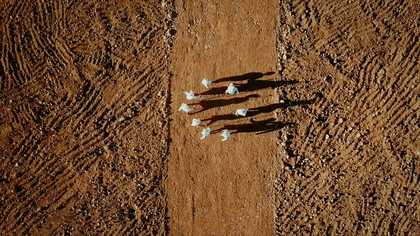Alternating videos by two artists explore themes of ritual, circular time, and the relationship between body, land and labour
Siwani’s Amahubo is part of her wider practice of restoration and healing, drawn from her work as one of the iSangoma – Zulu healers who perform rituals of transformation. The artist said, ‘the body is a vessel for all of these ancestral things which were demonised in Africa,’ referring to a long history of contesting religious beliefs. Amahubo features eight women performing a choreographic ritual, acknowledging their ancestral relationship to the land. The white and red of their robes suggests the dress of spiritual groups, recalling the iSangoma as well as African Zionists – a southern African religion drawing from both African and Christian cultures. The circular motion of the women in Amahubo refers to a cyclical understanding of time, one associated with healing practices and spirituality.
Marcelle’s Leitmotiv proposes an alternative form of ritual. It opens with an overhead shot of a concrete floor, an industrial material echoed in the Tanks. Water and foam wash across the screen, the source of these waves revealed by the sweeping action of brooms. By initially leaving the handlers outside the frame, Marcelle emphasises the anonymity of maintenance while also making visible its ritual. The artist explained, 'The extraordinary may come from repetition, as an effect of its accumulation… It is about placing the mechanical side of a job within a new dynamics and new systems, in order to produce the “extraordinary”.’
Your presence becomes part of the choreography of the space as you turn to face the alternating videos – a physical reflection of the cycles of life referenced in the artworks.

